Anthurium veitchii, or as it is commonly referred to as the King Anthurium, is a tropical plant with long ribbed green leaves and is one of the most coveted plants by aroid enthusiasts and serious collectors alike. And for a good reason. This long-leaf anthurium with a corrugated, ribbed-like appearance has a truly royal presence. Together with Queen Anthurium (Anthurium warocqueanum), this couple of royals rule the aroid plant kingdom.
This blog is all about Anthurium veitchii and covers optimal growing conditions and expert care tips. I will emphasize creating the right potting mix and include my soilless aroid mix recipe so you can enjoy growing the king anthurium.
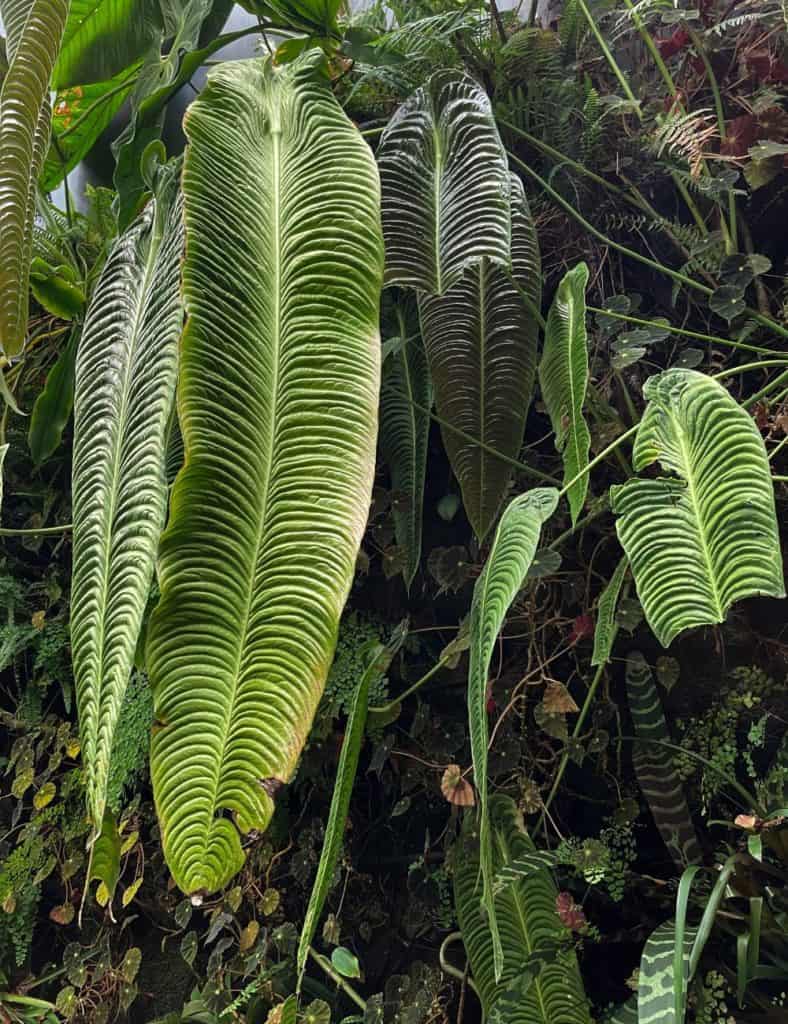
ANTHURIUM VEITCHII – THE KING OF ANTHURIUMS
Anthurium veitchii, also known as the King Anthurium, is an aroid native to the tropical rainforests of Colombia where it grows as an epiphyte. The leaves are light to mid-green and heavily corrugated, giving an appearance of ‘abs.’
The spadix is unexciting, plain white in color but it’s the large leaves that are the key reason why this aroid is in many collections.
It belongs to the Calomystrium section, the same section as Anthurium recavum.
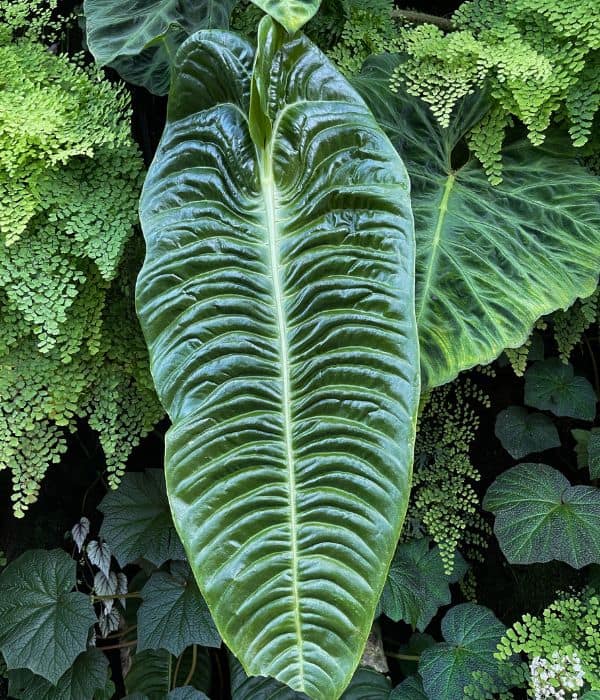
Anthurium veitchii seedlings and new leaves
Many seedlings and juvenile plants look nothing like mature plants. This is especially true for philodendrons but also for anthuriums.
You might be surprised to know that the ribbed appearance on Anthurium veitchii leaves is visible on seedlings already. As the plant matures and the leaves size up, the ribs become more pronounced and the leaves much longer.
The new leaves are usually flush orange or rusty in color, but they can emerge green as well. It depends on temperature, environmental conditions, or specific form.
Like other anthuriums, veitchii’s new leaves are floppy and easily get damaged. As the leaves expand over time, the smallest tear becomes a huge rip. Resist the temptation of “helping” the leaves unfurl.
Given proper care, Anthurium vietchii will consistently put out larger leaves until they reach their mature size.
Mature anthurium veitchii – the king of epiphytic anthuriums
When fully grown, King Anthurium veitchii is a true ruler with the leaves reaching up to 4-6 feet (1-2m) in length. King Anthurium veitchii is one of the largest epiphytic anthuriums. The texture of the leaves is coriaceous, or leathery, to the touch and quite thick. The ‘ears’ overlap on a mature specimen. The super narrow form is particularly attractive.
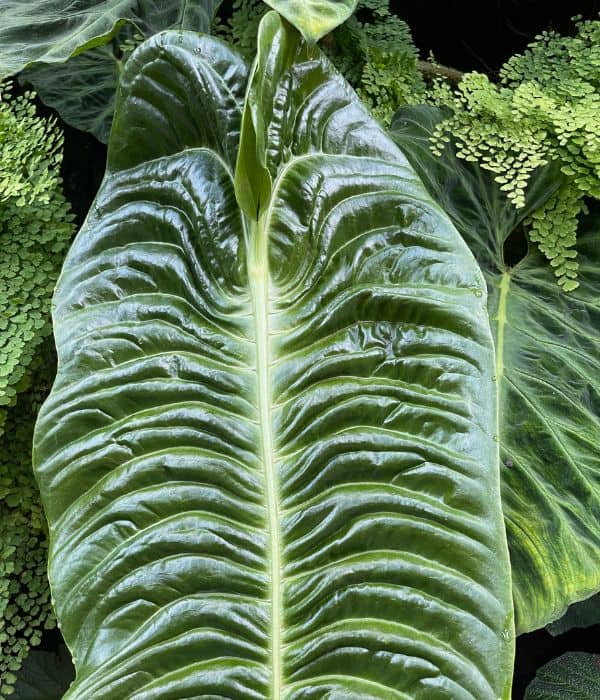
Anthurium veitchii forms – regular, wide, narrow or super narrow?
Let’s talk forms. When describing Anthurium veitchii, people often describe them as “regular,” “wide,” or “narrow form.” How to distinguish which form you have? These terms refer to:
1) the shape of the corrugated leaves, how slender or narrow the shape is.
2) how close together the ribs are. More scientifically speaking, how the lateral veins are spaced. The lateral veins are the secondary veins that emerge from the midvein and run toward the leaf margin. Think how tightly the veins are arranged together. The more ‘ribbed’ the leaf, the higher chance it is the narrow form.
3) The narrow form has a deeper sinus between the lobes compared to other forms.
The regular and wide forms are often interchangeable when referred to. The narrow form will have slender leaves with the veins closely spaced, while the wide form has wider leaves and more spaced-out veins. But often, it is challenging to say which form it is. The more mature plant, the easier is to tell. It is very difficult to ascertain this on a juvenile plant or seedling. The narrow form is especially sought after.
The appearance of a wide or narrow form may depend on growing conditions. Anthuriums in general, and Anthurium veitchii in particular, are highly variable species. Meaning, in the wild, depending on where they grow and under which environmental conditions, they may exhibit different looks. There is quite a bit of variation among the plants within the same species.
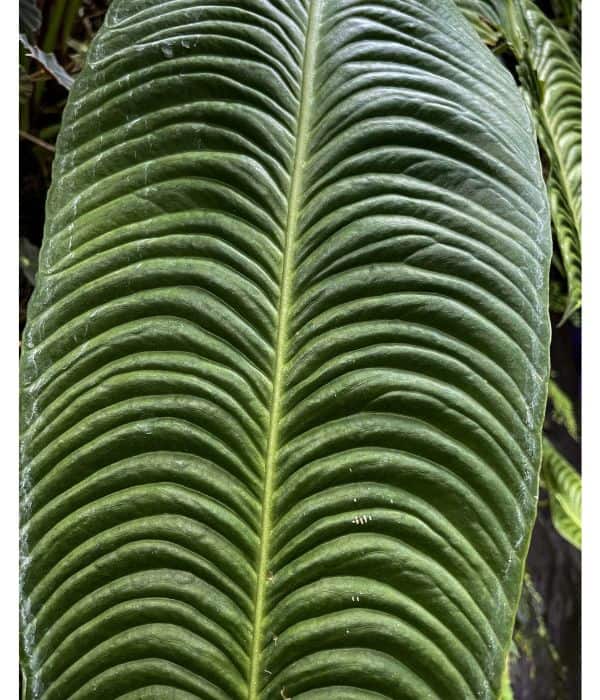
HOW TO ACCLIMATIZE A VEITCHII
Acclimatizing a plant to your growing conditions comes with a risk of the plant not making it. Shipping stress, drastic temperature changes, and changes in the growing medium are just some of the factors that may affect whether your plant will survive or not.
But fear not, we’ll cover ; minethe steps to take to give your Anthurium veitchii the best chance of survival.
There are many ways to care for a plant, and mine is certainly a way, not the way. One of the reasons I find this hobby fascinating is the many ways you can grow a plant and see it thrive.
If you’re considering ordering the plant online and having it shipped to you, check out my other blog where I wrote about points to consider when ordering anthurium warocqueanum online. The principles apply to any shipped plant.
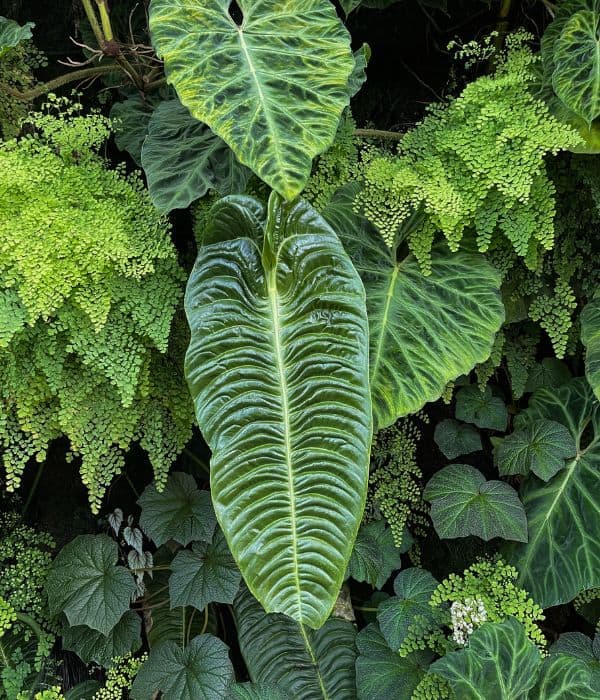
3 Steps to Acclimatizing an Anthurium Veitchii
1. Inspect the roots
Are the roots dry and brittle or firm and juicy? If the roots are dried out, chop them off. They will rot in soil or water. If you’re left with no roots, put the chonk in your preferred propagation medium. I use sphagnum moss but you can use perlite too, for example. If the roots are in good shape, proceed to the next step.
2. Rehydrate
Chances are your veitchii will come severely dehydrated. If there was a shipping delay, the situation might be even more dire. If your plant came with its roots wrapped up in sphagnum moss or potting soil, I’d remove the medium and put it in water for the next 24hrs.
3. Pot up
Given various countries’ restrictions on importing live material, it is unlikely your international shipment would come in potted up. Domestic shipments might, in which case, I would leave the plant for a while in its growing medium not to add to its stress. Unless, of course, you see the potting medium to be absolutely not suitable. In which case, repot immediately!
When potting up a newly arrived plant, a rule of thumb is to use the same medium it was grown in by a seller since the plant is already accustomed to it.
But I don’t follow this advice, and here is why.
The growers who grow plants commercially at scale will use whatever growing medium is best for their conditions and is the cheapest. You will never be able to recreate such conditions in your home so I’d recommend using the ideal medium for your conditions from the beginning.
Very often transplanting the plant into a new substrate will force it to abort the roots and grow new ones better suited to the new environment.
Sometimes plants will adapt just fine, sometimes they won’t and will either die or lose their leaves completely, and you’ll be left with a bare chonk.
You can still save it by propagating and rehabilitating it, but the process will have to restart. Just something to consider when you’re importing plants internationally.
Your best bet is to try and source the plant locally—higher chances of survival and a more sustainable way.
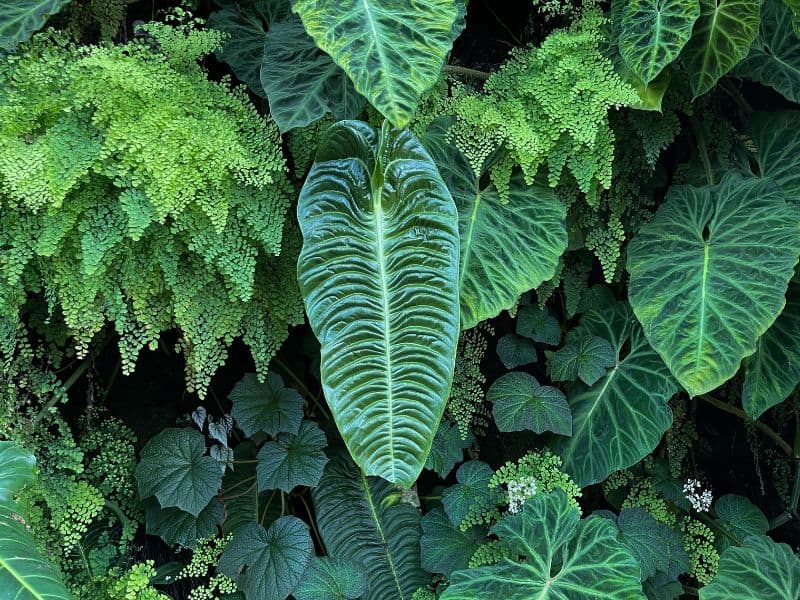
ANTHURIUM VEITCHII CARE
A regal plant deserves royal care. Here are expert tips for growing Anthurium veitchii.
POTTING MIX
With the right potting mix, Anthurium veitchii can thrive. Soil choice is the key element for success – don’t risk failure by cutting corners!
And for the love of god, do not ever use the all-purpose garden soil. It will suffocate the roots, and you will have to say good bye to your Anthurium veitchii.
Selecting the right potting mix for your Anthurium veitchii depends on many factors, including your environmental conditions (outdoor, indoor outside a tent/growing cabinet, or indoor but inside the tent), your watering habit, and personal preferences, to name a few.
Anthurium enthusiasts use various potting mediums, such as sphagnum moss, pon, or aroid mix.
My preferred growing medium is a soilless aroid potting mix, which I create myself and will share on this blog.
You can also buy ready-made potting mixes suitable for aroids or even specifically for anthuriums, philodendrons, or alocasias.
Many houseplant enthusiasts often wonder how chunky a potting substrate should they use and should that change for different anthurium varieties, stages of growth, and pot sizes.
I had the same questions at the beginning. And to my disappointment, most of the advice found online is, to say the least, unhelpful.
To spare your frustration, here is a guide I hope is somewhat helpful to you.
Fine-tuning the exact potting mix is somewhat of an art, but here is the recipe that works for me.
After some experimentation, I’m sure you’ll find what works for you.
Soilless Aroid Mix Recipe:
1.Orchid bark
Orchid bark, as it is commonly referred to, comes from pine tree bark and is used mainly as a substrate to grow orchids. But given its excellent soil amendment properties, it is widely used by aroid growers as part of the soilless potting mix.
The New Zealand Orchiata Orchid Bark I like to use comes in different sizes, giving you flexibility in use for different types of aroids.
I use bigger size orchid bark for epiphytic types of anthuriums, such as veitchii or warocqueanum. I buy it from local nurseries, but you can buy it on Amazon or your local online marketplace.
The orchid bark is the main ingredient and takes up the bulk of my potting mix.
There are several benefits of using orchid bark in your potting mix:
- Since Anthurium veitchii is an epiphyte that grows on trees, the orchid bark simulates the bark of a tree and the roots love to attach themselves to it.
- It provides excellent drainage as aroids like their roots moist but don’t like to sit in water.
- It allows for great air circulation providing the right conditions for healthy root development.
- It is a natural and biodegradable material that breaks down over time and doesn’t harm the natural environment.
2. Perlite
Perlite is a naturally occurring volcanic glass that expands under high heat. It is very porous and an excellent soil amendment. The main benefits of perlite include extra aeration and improved drainage. I like to use coarse perlite in my aroid potting mix as it is less prone to compaction and is excellent for drainage. Perlite is generally inexpensive but if you can spend a bit extra, try to buy better grade and quality substrate. Low-quality perlite crumbles easily, leaving white dust rather than coarse particles necessary for drainage.
3. Coco coir
Coco coir, also called coconut fiber, is extracted from the outer husk of a coconut. It is an excellent and natural amendment to the aroid potting mix as it is water retentive and biodegradable.
I prefer to use coco coir as it is more sustainable than peat moss, although it is not ideal either as it uses a lot of water during the processing stage.
Also, coco coir doesn’t have nutrients, so it is critical to provide your plant with a balanced fertilizer.
4. Horticultural charcoal
An activated charcoal is created through a process of burning carbon-rich materials such as wood or coconut shells. It creates a more porous mix aiding in drainage and preventing the roots from being waterlogged.
It is highly absorbent as it absorbs the added fertilizer to the mix and slowly releases it over time. It reduces bacteria in the mix and balances potting mix acidity.
An activated charcoal is a great amendment to use to prevent bacterial and fungal diseases.
5. Worm castings
Worm castings is a natural fertilizer made by earthworms. Simply put, it is worm poop.
I like to add a bit of worm castings to freshly made aroid mixes for an extra nutrient boost.
You can also sprinkle some on top of the soil for your existing plants if you like to natural fertilizer and avoid otherwise unnecessary repotting.
How chunky should your aroid potting mix be?
The simple answer is ‘it depends.’ Multiple factors influence how chunky your potting mix should be, such as:
1) what type of anthurium it is (terrestrial or epiphytic),
2) plant growth stage,
3) pot size, and finally,
4) your watering habit.
Let’s break it down.
1) For epiphytic anthuriums such as veitchii or warocqueanum, I’ll make a chunkier mix by adding bigger orchid bark and perlite. For terrestrial types of anthuriums such as Anthurium magnificum or crystallinum, I’ll use a bit more water-retentive but still well-draining aroid mix with smaller particles.
2) A seedling would require a different mix than a mature specimen. A chunky mix for a seedling is unsuitable as it dries out too quickly.
Seedlings, in general, prefer a bit heavier mix than mature plants with large root systems already developed.
3) The more potting medium in the pot, the higher the chance of it being waterlogged. While the top surface might dry fast, the bottom layer may become compacted and too heavily water retentive.
The rule of thumb is the larger the pot, the chunkier the mix should be for Anthurium veitchii. I use clear plastic pots to monitor the dryness of the potting mix throughout the week.
4) If you’re an overwaterer like I am, a chunkier potting mix will be your friend. If you tend to forget about watering your plants, use a bit more water-retentive mix.
LIGHT
Light is the second most important factor for growing Anthurium veitchii to its full potential.
Anthurium veitchii is an epiphytic plant that grows on trees in dense tropical rainforests and therefore has higher light needs than a terrestrial kind of anthurium.
If you’re growing your King Anthurium indoors, keep it under grow lights or close to a well-lit window. It needs bright indirect light for at least 8 hours a day.
If you live in a place with a winter season and shorter days, you’ll need to supplement it with grow lights. Natural light won’t be enough.
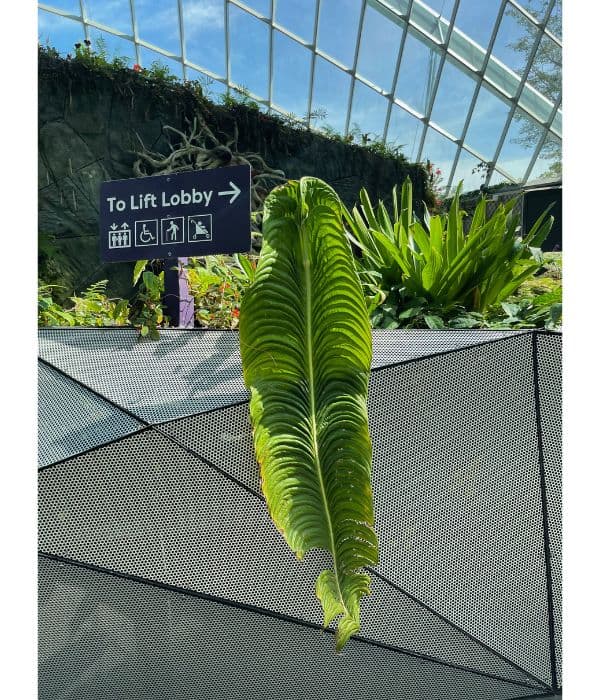
HUMIDITY & AIR FLOW
Given its natural environment of tropical rainforest, Anthurium veitchii naturally enjoys high humidity.
As with many tropical plants grown indoors, acclimatizing to your specific conditions is key to long-term success. All my aroids grow in ambient humidity of 50-55% year-round.
If your conditions have lower humidity levels than 50%, I recommend getting a humidifier.
They can grow in lower humidity, but that environment is not optimal for their overall health and growth.
Ensure that your humidity also goes with the right airflow. Having super high humidity requires very high airflow.
The lower humidity, the higher the chances of new leaves ripping when emerging and expanding. I mist the newly emerging leaves as a prevention measure against ripping. Works like a charm.
TEMPERATURE
Naturally, Anthurium veitchii enjoys warm temperatures all year round, so if you’re growing it indoors during the winter, ensure the temperature doesn’t dip below 16-20C.
A slight temperature drop at night is fine, but veitchii is not like Anthurium cutucuense which requires a drop in temperature to thrive. As always, try to imitate as much as possible its natural environment, and it will reward you with steady growth.
FERTILIZER
Fertilizer is key to growing a strong and healthy Anthurium veitchii. Your choice of fertilizer will depend on the growing medium.
For example, if you’re growing your King Anthurium in leca, you shouldn’t be using organic fertilizer in a soilless potting medium as there isn’t enough biomass to break it down and absorb by the roots.
But if you’re using an aroid mix consisting of chunky organic and inorganic matter, worm castings added to the mix, and then liquid fertilizer with watering will go a long way.
An epiphyte fertilizer used mainly for orchids will work well too.
Where & how to buy a veitchii – a buyers guide
First, try sourcing it locally. A local plant store that carries aroids might have it. Usually, some small bespoke plant shops will carry a small selection of aroids. I wouldn’t keep my hopes high of getting a veitchii at a plant store or nursery that carries common plants.
Another option is to try your local Facebook groups, or Instagram lives where other aroid enthusiasts sell cuttings or seeds. This would probably be your best bet, as the plant would already be acclimatized to your local conditions.
If all else fails, you can buy it online and have it shipped from abroad. But ordering plants online carries a significant risk.
Check out my Anthurium warocqueanum blog on things to consider when ordering and acclimatizing internationally sourced plants.
Be aware that Anthurium veitchii is in quite high demand, so expect to pay a premium price for it.
I hope this Anthurium veitchii care guide helped you understand the optimal growing conditions and needs of this truly magnificent plant.
This blog will be updated with the most common problems, pests, and diseases found when growing Anthurium veitchii indoors.

